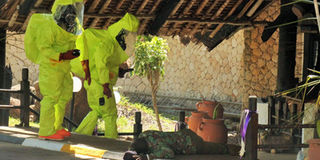Police ready for bio-chemical response after US training

Kenya Defence Forces (KDF) Disaster Response Unit arrive in their special protective gear fitted with oxygen cylinders at a bio-chemical attack scene at Alliance Safari Beach in Diani, Kwale County on April 21, 2016 during a drill exercise on the preparedness to handle a bio- chemical threat. PHOTO | WACHIRA MWANGI | NATION MEDIA GROUP
What you need to know:
- The soldiers, on Thursday, displayed their proficiency during a simulation exercise conducted by a joint team of Kenya Police, Kenya Defense Forces, Border Police, General Service, Marine Police, and Ministry of Health on the preparedness to counter disasters at Alliance Safari Beach resort in Diani, Kwale County.
- Representing the US Embassy, CDC Kenya Deputy Director Marc-Alain Widdowson said the initiative was aimed at enhancing coordination and cooperation among public and private agencies in addition to civilian and military personnel in the event of mass casualties.
Kenyan security agents say they are now better skilled and equipped to handle any Bio- chemical threat facing the country, after intensive training in the United States.
At least 30 Kenya Defence Forces (KDF) soldiers have successfully gone through the training and are ready to be deployed regionally to handle such threats.
The soldiers, on Thursday, displayed their proficiency during a simulation exercise conducted by a joint team of Kenya Police, Kenya Defense Forces, Border Police, General Service, Marine Police, and Ministry of Health on the preparedness to counter disasters at Alliance Safari Beach resort in Diani, Kwale County.
National Disaster operations Centre Director Nathan Kigotho said the country disaster profile in Kenya included; droughts, floods, landslides and epidemics.
He said road accidents, structural collapse, terrorism, aircraft accidents are however human induced.
“Terrorism is ranked as the leading contributors to disaster related deaths in Kenya. Given this level of threat, there is an urgent need to increase the level of preparedness to combat this threat,” Mr Kigotho.
The NDOC director acknowledged that with the rise in terrorism, the threat towards bio-chemical, radiological and nuclear was on the increase.
“We are prepared in responding to chemical, biological and nuclear contamination. The new capability that our KDF Disaster Response Unit has acquired gives us a lot of confidence that we are more prepared. We appreciate all the assistance given to us through recruitment and training by the US Government,” he said.
Representing the US Embassy, CDC Kenya Deputy Director Marc-Alain Widdowson said the initiative was aimed at enhancing coordination and cooperation among public and private agencies in addition to civilian and military personnel in the event of mass casualties.
Mr Widdowson said that Kenya had taken extraordinary steps in securing its borders, ports and waters since the Westgate Mall and Garissa University College attacks.
“The KDF now possess a state of the art detection, identification and decontamination equipment. They have also been trained to a high level of excellence that has made it to be recognised as international leader in Chemical-biological-radiological (CBR) Response capabilities,” he added.
The National Counter terrorism Centre Director Martin Kimani said the fight against terrorism required agencies to work together.
“Had this been a terrorist incident, the speed and effectiveness of our response is very critical in demonstrating that we have the capability to respond adequately to them. Terrorists seek to do harm so as to terrorise our people,” Dr Kimani said.
“Through working with the Kenyan people, we are deterring and preventing more potential attacks. Our job is to defend you but we depend on you to come together to avert attacks,” he said.
Kenya Red Cross Secretary General Abbas Gullet said he was proud of the level of coordination in the simulation drill.





